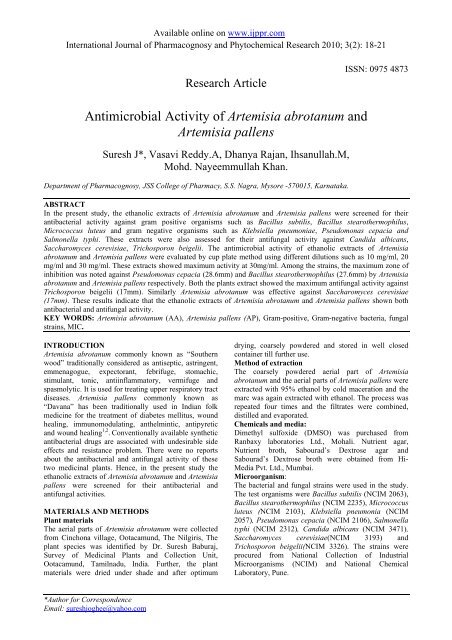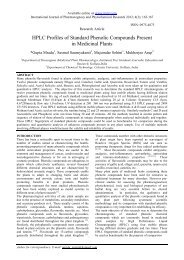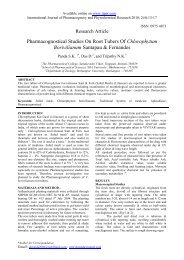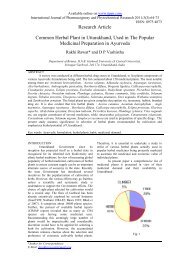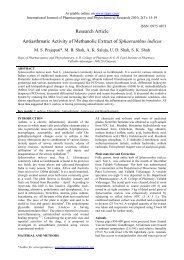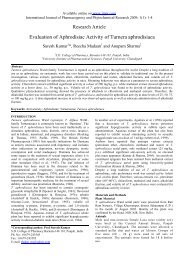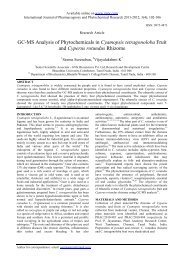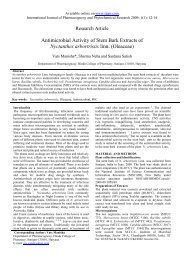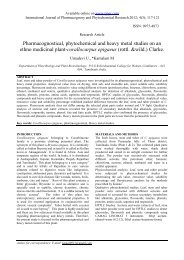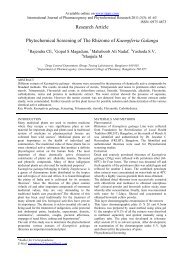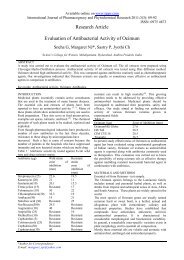antimicrobial activity of artemisia abrotanum and artemisia pallens
antimicrobial activity of artemisia abrotanum and artemisia pallens
antimicrobial activity of artemisia abrotanum and artemisia pallens
You also want an ePaper? Increase the reach of your titles
YUMPU automatically turns print PDFs into web optimized ePapers that Google loves.
Available online on www.ijppr.com<br />
International Journal <strong>of</strong> Pharmacognosy <strong>and</strong> Phytochemical Research 2010; 3(2): 18-21<br />
Research Article<br />
ISSN: 0975 4873<br />
Antimicrobial Activity <strong>of</strong> Artemisia <strong>abrotanum</strong> <strong>and</strong><br />
Artemisia <strong>pallens</strong><br />
Suresh J*, Vasavi Reddy.A, Dhanya Rajan, Ihsanullah.M,<br />
Mohd. Nayeemmullah Khan.<br />
Department <strong>of</strong> Pharmacognosy, JSS College <strong>of</strong> Pharmacy, S.S. Nagra, Mysore -570015, Karnataka.<br />
ABSTRACT<br />
In the present study, the ethanolic extracts <strong>of</strong> Artemisia <strong>abrotanum</strong> <strong>and</strong> Artemisia <strong>pallens</strong> were screened for their<br />
antibacterial <strong>activity</strong> against gram positive organisms such as Bacillus subtilis, Bacillus stearothermophilus,<br />
Micrococcus luteus <strong>and</strong> gram negative organisms such as Klebsiella pneumoniae, Pseudomonas cepacia <strong>and</strong><br />
Salmonella typhi. These extracts were also assessed for their antifungal <strong>activity</strong> against C<strong>and</strong>ida albicans,<br />
Saccharomyces cerevisiae, Trichosporon beigelii. The <strong>antimicrobial</strong> <strong>activity</strong> <strong>of</strong> ethanolic extracts <strong>of</strong> Artemisia<br />
<strong>abrotanum</strong> <strong>and</strong> Artemisia <strong>pallens</strong> were evaluated by cup plate method using different dilutions such as 10 mg/ml, 20<br />
mg/ml <strong>and</strong> 30 mg/ml. These extracts showed maximum <strong>activity</strong> at 30mg/ml. Among the strains, the maximum zone <strong>of</strong><br />
inhibition was noted against Pseudomonas cepacia (28.6mm) <strong>and</strong> Bacillus stearothermophilus (27.6mm) by Artemisia<br />
<strong>abrotanum</strong> <strong>and</strong> Artemisia <strong>pallens</strong> respectively. Both the plants extract showed the maximum antifungal <strong>activity</strong> against<br />
Trichosporon beigelii (17mm). Similarly Artemisia <strong>abrotanum</strong> was effective against Saccharomyces cerevisiae<br />
(17mm). These results indicate that the ethanolic extracts <strong>of</strong> Artemisia <strong>abrotanum</strong> <strong>and</strong> Artemisia <strong>pallens</strong> shown both<br />
antibacterial <strong>and</strong> antifungal <strong>activity</strong>.<br />
KEY WORDS: Artemisia <strong>abrotanum</strong> (AA), Artemisia <strong>pallens</strong> (AP), Gram-positive, Gram-negative bacteria, fungal<br />
strains, MIC.<br />
INTRODUCTION<br />
Artemisia <strong>abrotanum</strong> commonly known as “Southern<br />
wood” traditionally considered as antiseptic, astringent,<br />
emmenagogue, expectorant, febrifuge, stomachic,<br />
stimulant, tonic, antiinflammatory, vermifuge <strong>and</strong><br />
spasmolytic. It is used for treating upper respiratory tract<br />
diseases. Artemisia <strong>pallens</strong> commonly known as<br />
“Davana” has been traditionally used in Indian folk<br />
medicine for the treatment <strong>of</strong> diabetes mellitus, wound<br />
healing, immunomodulating, anthelmintic, antipyretic<br />
<strong>and</strong> wound healing 1,2 . Conventionally available synthetic<br />
antibacterial drugs are associated with undesirable side<br />
effects <strong>and</strong> resistance problem. There were no reports<br />
about the antibacterial <strong>and</strong> antifungal <strong>activity</strong> <strong>of</strong> these<br />
two medicinal plants. Hence, in the present study the<br />
ethanolic extracts <strong>of</strong> Artemisia <strong>abrotanum</strong> <strong>and</strong> Artemisia<br />
<strong>pallens</strong> were screened for their antibacterial <strong>and</strong><br />
antifungal activities.<br />
MATERIALS AND METHODS<br />
Plant materials<br />
The aerial parts <strong>of</strong> Artemisia <strong>abrotanum</strong> were collected<br />
from Cinchona village, Ootacamund, The Nilgiris, The<br />
plant species was identified by Dr. Suresh Baburaj,<br />
Survey <strong>of</strong> Medicinal Plants <strong>and</strong> Collection Unit,<br />
Ootacamund, Tamilnadu, India. Further, the plant<br />
materials were dried under shade <strong>and</strong> after optimum<br />
drying, coarsely powdered <strong>and</strong> stored in well closed<br />
container till further use.<br />
Method <strong>of</strong> extraction<br />
The coarsely powdered aerial part <strong>of</strong> Artemisia<br />
<strong>abrotanum</strong> <strong>and</strong> the aerial parts <strong>of</strong> Artemisia <strong>pallens</strong> were<br />
extracted with 95% ethanol by cold maceration <strong>and</strong> the<br />
marc was again extracted with ethanol. The process was<br />
repeated four times <strong>and</strong> the filtrates were combined,<br />
distilled <strong>and</strong> evaporated.<br />
Chemicals <strong>and</strong> media:<br />
Dimethyl sulfoxide (DMSO) was purchased from<br />
Ranbaxy laboratories Ltd., Mohali. Nutrient agar,<br />
Nutrient broth, Sabourad’s Dextrose agar <strong>and</strong><br />
Sabourad’s Dextrose broth were obtained from Hi-<br />
Media Pvt. Ltd., Mumbai.<br />
Microorganism:<br />
The bacterial <strong>and</strong> fungal strains were used in the study.<br />
The test organisms were Bacillus subtilis (NCIM 2063),<br />
Bacillus stearothermophilus (NCIM 2235), Micrococcus<br />
luteus (NCIM 2103), Klebsiella pneumonia (NCIM<br />
2057), Pseudomonas cepacia (NCIM 2106), Salmonella<br />
typhi (NCIM 2312), C<strong>and</strong>ida albicans (NCIM 3471),<br />
Saccharomyces cerevisiae(NCIM 3193) <strong>and</strong><br />
Trichosporon beigelii(NCIM 3326). The strains were<br />
procured from National Collection <strong>of</strong> Industrial<br />
Microorganisms (NCIM) <strong>and</strong> National Chemical<br />
Laboratory, Pune.<br />
*Author for Correspondence<br />
Email: sureshjoghee@yahoo.com
Suresh et al. / Antimicrobial <strong>activity</strong> <strong>of</strong> Artemisia <strong>abrotanum</strong>…<br />
Table 1: Antibacterial <strong>activity</strong> <strong>of</strong> the ethanolic extracts <strong>of</strong> Artemisia <strong>abrotanum</strong> <strong>and</strong> Artemisia <strong>pallens</strong> by cup<br />
plate method<br />
S.No Organisms<br />
Diameter <strong>of</strong> Zone <strong>of</strong> Inhibition in mm<br />
Artemisia <strong>abrotanum</strong><br />
Conc (mg/ml)<br />
Artemisia <strong>pallens</strong><br />
Conc (mg/ml<br />
10 20 30 STD 10 20 30 STD<br />
GRAM POSITIVE STRAINS<br />
1 Bacillus subtilis 00 00 00 15.0 00 00 00 15.0<br />
2 Bacillus<br />
-- 18.5 20.6 24.8 21.0 24.5 27.6 30.0<br />
stearothermophilus<br />
3 Micrococcus luteus -- 19.3 20.1 23.4 22.2 24.2 26.2 31.4<br />
GRAM NEGATIVE STRAINS<br />
1 Klebsiella pneumoniae -- 12.3 14.4 20.4 21.1 24.3 27.4 32.3<br />
2 Pseudomonas cepacia 24.6 26.6 28.6 31.4 10.1 17.3 19.6 24.8<br />
3 Salmonella typhi 10.1 11.1 13.0 15.7 10.9 20.1 18.0 20.1<br />
Preparation <strong>of</strong> micro organism<br />
One loop-full <strong>of</strong> microorganism was inoculated into 100<br />
ml <strong>of</strong> sterile medium <strong>and</strong> incubated for 24 h at 37º C for<br />
bacterial culture <strong>and</strong> for 48 h at 27º C for fungal culture.<br />
After 24 h / 48 h <strong>of</strong> incubation 1 ml <strong>of</strong> broth containing<br />
the microorganism was added into 9 ml <strong>of</strong> peptone<br />
water. Ten fold serial dilutions were made in the range<br />
<strong>of</strong> 10 –1 to 10 –8 . 100 μl <strong>of</strong> the dilutions ranging from 10 –5<br />
to 10 –8 were spread on the sterile nutrient agar/SDA<br />
plates <strong>and</strong> kept at 37º C or 27º C for 24 h / 48 h. The<br />
numbers <strong>of</strong> colony forming units were counted <strong>and</strong><br />
numbers <strong>of</strong> microorganisms in each ml <strong>of</strong> stock culture<br />
were calculated. 3, 4<br />
St<strong>and</strong>ard drugs<br />
Penicillin (1mg/ml) diluted with dimethylsulphoxide was<br />
used as st<strong>and</strong>ard antibacterial drug. Amphotericin - B<br />
(500 μl/) in sterile water was used as st<strong>and</strong>ard antifungal<br />
drug. Dimethylsulphoxide was used as a control for the<br />
study.<br />
Screening <strong>of</strong> antibacterial <strong>and</strong> antifungal <strong>activity</strong> by<br />
cup plate method<br />
The antibacterial <strong>and</strong> antifungal <strong>activity</strong> <strong>of</strong> ethanolic<br />
extracts <strong>of</strong> Artemisia <strong>abrotanum</strong> <strong>and</strong> Artemisia <strong>pallens</strong><br />
were evaluated by cup plate method using different<br />
dilutions viz., 10 mg/ml, 20 mg/ml <strong>and</strong> 30 mg/ml.<br />
Sterilized nutrient agar plates were prepared under<br />
aseptic conditions. Six mm diameter holes were made in<br />
the agar plates using a sterile borer. 0.1 ml <strong>of</strong> the test<br />
organisms was spreaded on agar plates. Samples,<br />
st<strong>and</strong>ard drug <strong>and</strong> the solvent control (DMSO) were<br />
added into each hole separately. The plates were<br />
maintained at +4º C for 1 h to allow the diffusion <strong>of</strong><br />
solution into the agar medium. The plates were<br />
incubated at 37ºC for 24 h for bacteria <strong>and</strong> 28ºC for 48h<br />
for fungi. The zone <strong>of</strong> inhibition was measured using<br />
5, 6, <strong>and</strong> 7<br />
antibiotic zone reader.<br />
Determination <strong>of</strong> Minimum Inhibitory<br />
Concentration:<br />
Minimum Inhibitory Concentration was determined by<br />
two-fold serial dilution method. A series <strong>of</strong> test tubes<br />
were prepared containing the same volume <strong>of</strong> media<br />
inoculated with the test organism (the inoculums may<br />
vary from 10 3 to 10 6 cells per milliliter). Drug was added<br />
to the tubes in a stepwise dilution by a factor <strong>of</strong> 2 (two<br />
fold serial dilution) that is if the concentration <strong>of</strong> drug in<br />
the first tube is 500 mg/ml, in the second tube it will be<br />
250 mg/ml <strong>and</strong> in the third 125 mg/ml <strong>and</strong> so on.<br />
Cultures were incubated at 24 h for bacteria at 37ºC <strong>and</strong><br />
48 h for fungi at 27ºC. One tube was left without drug to<br />
serve as a positive control for the growth <strong>of</strong> the<br />
organism. Tubes are inspected visually to determine the<br />
growth <strong>of</strong> the organism indicated by turbidity. 7<br />
RESULTS AND DISCUSSION<br />
The ethanolic extract <strong>of</strong> AA was found to be effective<br />
against various bacteria as indicated by the zone <strong>of</strong><br />
inhibition. Maximum inhibition was obtained against<br />
Pseudomonas cepacia (28.6 mm) followed by Klebsiella<br />
pneumoniae (26.4 mm), Microccus luteus (25.4 mm),<br />
Salmonella typhi (22.0 mm) <strong>and</strong> Bacillus<br />
Table2: Antifungal <strong>activity</strong> <strong>of</strong> the ethanolic extract <strong>of</strong> Artemisia <strong>abrotanum</strong> <strong>and</strong> Artemisia <strong>pallens</strong> by cup plate<br />
method:<br />
Diameter <strong>of</strong> Zone <strong>of</strong> Inhibition in mm<br />
Sl.N<br />
o<br />
Organisms<br />
Artemisia <strong>abrotanum</strong><br />
Conc (mg/ml)<br />
Artemisia <strong>pallens</strong><br />
Conc (mg/ml)<br />
10 20 30 STD 10 20 30 STD<br />
1 C<strong>and</strong>ida albicans 05 15 16 19 00 05 16 23<br />
2 Saccharomyces cerevisiae 03 16 17 26 00 09 10 24<br />
3 Trichosporon beigelii 03 15 17 21 03 16 17 26<br />
IJPPR June 2011 -August 2011, Volume 3, Issue 2(18-21) 19
Suresh et al. / Antimicrobial <strong>activity</strong> <strong>of</strong> Artemisia <strong>abrotanum</strong>…<br />
Table 3: Antibacterial <strong>and</strong> antifungal <strong>activity</strong> <strong>of</strong> the Artemisia <strong>abrotanum</strong> <strong>and</strong> Artemisia <strong>pallens</strong> by two fold<br />
serial dilution method:<br />
MIC in μg/ml<br />
S.No Organisms<br />
AA<br />
AP<br />
Gram positive strains<br />
1 Bacillus stearothermophilus 250 250<br />
2 Micrococcus luteus 500 500<br />
Gram negative strains<br />
1 Klebsiella pneumoniae 250 500<br />
2 Pseudomonas cepacia 500 125<br />
3 Salmonella typhi 125 250<br />
Fungal strains<br />
1 C<strong>and</strong>ida albicans 250 1000<br />
2 Saccharomyces cerevisiae 125 500<br />
3 Trichosporon beigelii 125 500<br />
stearothermophilus (20.6 mm) at a concentration <strong>of</strong> 30<br />
mg/ml.The ethanolic extract <strong>of</strong> AP was found to be<br />
effective against various bacteria as indicated by zone <strong>of</strong><br />
inhibition. Maximum inhibition was obtained against<br />
Bacillus stearothermophilus (27.6 mm) followed by<br />
Klebsiella pneumoniae (27.4 mm), Microccus luteus<br />
(26.2 mm), Salmonella typhi (20.1 mm), Pseudomonas<br />
cepacia (19.6 mm) at a concentration <strong>of</strong> 30mg/ml. The<br />
results are shown in figure table 1.<br />
The ethanolic extract <strong>of</strong> AA was found to be effective<br />
against various fungi as indicated by the zone <strong>of</strong><br />
inhibition. Maximum inhibition was obtained against T.<br />
beigelii (17 mm) followed by S. serevisiae (17 mm) <strong>and</strong><br />
C. albicans (16 mm). The ethanolic extract <strong>of</strong> AP<br />
was found to be effective against inhibiting the growth<br />
<strong>of</strong> various fungi as indicated by zone <strong>of</strong> inhibition.<br />
Maximum inhibition was obtained for T. beigelii (17<br />
mm) followed by C.albicans (16 mm), S. cerevisiae<br />
(10mm). The results are shown in figure table 2.<br />
The ethanolic extracts <strong>of</strong> Artemisia <strong>abrotanum</strong> <strong>and</strong><br />
Artemisia <strong>pallens</strong> were found to be effective against all<br />
bacterial strains used in the study at a concentration <strong>of</strong><br />
10 to 30 mg/ml except Bacillus subtilis, which was<br />
found to be ineffective against the ethanolic extracts <strong>of</strong><br />
Artemisia <strong>abrotanum</strong>. The ethanolic extracts (AA)<br />
showed maximum inhibition against Pseudomonas<br />
cepacia <strong>and</strong> the Artemisia <strong>pallens</strong> was found to be more<br />
effective against Bacillus stearothermophilus. And the<br />
MIC results showed that the Salmonella typhii has the<br />
minimum MIC value against AA <strong>and</strong> Pseudomonas<br />
cepacia against AP (Table 1, Table 3).<br />
The ethanolic extract <strong>of</strong> Artemisia <strong>abrotanum</strong> <strong>and</strong><br />
Artemisia <strong>pallens</strong> was found to be effective against all<br />
the fungal strains used in the study. Both AA <strong>and</strong> AP<br />
extracts were found to be effective for Trichosporon<br />
beigelii. AA was also effective against Saccharomyces<br />
cerevisiae, Saccharomyces cervisiae <strong>and</strong> Trichosporon<br />
beigelii has the minimum MIC against both AA <strong>and</strong> AP<br />
(Table 2, Table 3). This <strong>activity</strong> may be attributed to the<br />
presence <strong>of</strong> terpenoids <strong>and</strong> flavanoids present in both the<br />
plant species.<br />
Human pathogenic microorganisms, phytopathogens, are<br />
prone to developing drug resistance to decrease<br />
substantially the effectiveness <strong>of</strong> those pesticides<br />
(Rosenberger <strong>and</strong> Meyer, 1981). There is an urgent need,<br />
therefore, to work towards the development <strong>of</strong> safer<br />
<strong>antimicrobial</strong> agents, that are expected to be renewable,<br />
non-petrochemical, naturally ec<strong>of</strong>riendly <strong>and</strong> easily<br />
obtainable.<br />
As an evolutionary process, plants on which insects,<br />
microorganisms <strong>and</strong> mammals are feeding, usually<br />
acquire self defending capabilities by producing a<br />
variety <strong>of</strong> secondary metabolites such as alkaloids,<br />
terpenoids, steroids <strong>and</strong> aromatic compounds, which are<br />
presumably unpleasant or even toxic to the enemy.<br />
Inside the tissue <strong>of</strong> nearly all the healthy plants, there are<br />
a lot <strong>of</strong> microorganisms called “endophytes”.<br />
Endophytes are mutualistic to their host, at least some <strong>of</strong><br />
them are thought to be making returns for the nutrition<br />
from the plant by producing special substances such as<br />
secondary metabolites to prevent the host from<br />
successful attack <strong>of</strong> fungi, pest <strong>and</strong> mammals. As a<br />
matter <strong>of</strong> fact, metabolites <strong>of</strong> endophytes were reported<br />
to inhibit a number <strong>of</strong> microorganisms (Fisher et al.,<br />
1984; Gurney et al., 1993).<br />
The terpenoids may interfere with the electron transport<br />
chain or oxidative phosphorylation or dissolve the<br />
cytoplasmic membrane due to their lipophilic properties<br />
(Parcha et al., 2003). Triterpenoids, certain flavonoids<br />
with <strong>antimicrobial</strong> <strong>and</strong> antifungal activities <strong>and</strong> biocides<br />
with insecticidal <strong>activity</strong>, have been reported (Sharma et<br />
al., 1989). Antimicrobial <strong>activity</strong> <strong>of</strong> methanolic extracts<br />
<strong>of</strong> aerial parts <strong>of</strong> Artemisia diffusa, A. oliveriana, A.<br />
scoparia <strong>and</strong> A. turanica against B. subtilis, S. aureus, E.<br />
coli, P. aeruginosa <strong>and</strong> C. albicans has been reported<br />
(Ramezani et al., 2004). Also, two flavones isolated<br />
IJPPR June 2011 -August 2011, Volume 3, Issue 2(18-21) 20
Suresh et al. / Antimicrobial <strong>activity</strong> <strong>of</strong> Artemisia <strong>abrotanum</strong>…<br />
from Artemisia giraldii have shown antibiotic <strong>activity</strong><br />
against S. aureus, S. lutea, E. coli, P. aeruginosa,<br />
Proteus sp., A. flavus <strong>and</strong> T. viride (Zheng et al., (1996).<br />
CONCLUSION<br />
In the present study, both the plant extracts <strong>and</strong> essential<br />
oils showed significant <strong>antimicrobial</strong> <strong>activity</strong> against<br />
Gram +ve <strong>and</strong> Gram –ve bacteria <strong>and</strong> fungi by cup plate<br />
<strong>and</strong> two fold serial dilution techniques <strong>and</strong> this <strong>activity</strong><br />
may be attributed to the presence <strong>of</strong> terpenoids <strong>and</strong><br />
flavanoids present in both the plant species.<br />
ACKNOWLEDGEMENT<br />
The authors sincerely thank Dr. H.G. Shivakumar,<br />
Principal, J.S.S. College <strong>of</strong> Pharmacy, Mysore, for his<br />
support <strong>and</strong> encouragement. Our gratitude goes to J.S.S.<br />
University, Mysore, for providing all the necessary<br />
facilities.<br />
REFERENCE<br />
1. Bjork L, Hedner T, Remberg P, Sterner O. Ethno<br />
botanical use <strong>of</strong> southern wormwood, Artemisia<br />
<strong>abrotanum</strong> L. in Europe, A critical review <strong>of</strong> its<br />
therapeutic use from<br />
ancient to modern medicine. Ethnopharmacologia 2<br />
002b.<br />
2. Asolkar LV, Kakkar KK, Chakre OJ. Glossary <strong>of</strong><br />
Indian medicinal plants with active principles. New<br />
Delhi: Publications & Information Directorate,<br />
CSIR, New Delhi, 1965 -1981; 92-97.<br />
3. Qadrie Zl, Jacob B, An<strong>and</strong>an R, Rajkapoor B,<br />
Rahamathulla M. Anti-bacterial <strong>activity</strong> <strong>of</strong> ethanolic<br />
extract <strong>of</strong> Indoneesiella echioides (l) Nees.<br />
Evaluated by the filter paper disc method. Pak J<br />
Pharm Sci 2009; 22(2):123-5.<br />
4. Hugo WB, Russell AD. Pharmaceutical<br />
Microbiology. Edn 4, Oxford: Blackwell Scientific<br />
Publications, London, 1987, 265–68.<br />
5. Yashphe J, Segal R, Breuer A, Erdreich-Naftali G.<br />
Antibacterial <strong>activity</strong> <strong>of</strong> Artemisia herba-alba. J<br />
Pharm Sci 1979; 68(7): 924-5.<br />
6. Khan A, Rahman M, Islam S. Antibacterial,<br />
antifungal <strong>and</strong> cytotoxic activities <strong>of</strong> tuberous roots<br />
<strong>of</strong> Amorphophallus campanulatus. Turk J Biol.,<br />
2007; 31:167-172.<br />
7. Manisha V, Neha S, Satish S. Antimicrobial<br />
Activity <strong>of</strong> Stem Bark Extracts <strong>of</strong> Nyctanthes<br />
arbortristis Linn. (Oleaceae). IJPPR, 2009; 1(1):12-<br />
14.<br />
8. Parcha V, Gahlot M, Bajaj BK. Antimicrobial<br />
<strong>activity</strong> <strong>of</strong> essential oil <strong>of</strong> Dysoxylum malbaricum.<br />
Indian. Perfum. 2003; 47(2): 183-187.<br />
9. Sharma OP,Sharma PD.Chemical composition <strong>of</strong><br />
fruits <strong>and</strong> stem essential oils <strong>of</strong> Lantana camara.<br />
J.Sci.Ind. 1989; 48:471-475.<br />
10. Ramezani M, Fazli-Bazzaz BS, Saghafi- Khadem<br />
F, Dabaghian A. Antimicrobial <strong>activity</strong> <strong>of</strong> four<br />
Artemisia species <strong>of</strong> Iran. Fitoterapia.2004; 75: 201-<br />
203.<br />
11. Zheng WF, Tan RX, Yang L, Liu ZL. Two flavones<br />
from Artemisia giraldii <strong>and</strong> their <strong>antimicrobial</strong><br />
<strong>activity</strong>. Planta Med. 1996; 62(2):160-2.<br />
12. Rosenberger DA, Meyer CW. Post harvest<br />
fungicides for apples: development <strong>of</strong> resistence to<br />
benomyl, vinclozolin <strong>and</strong> iprodione. Plant.<br />
Dis.1981; 65, 1010—1013.<br />
13. Fisher PJ, Anson AE, Petrini O. Antibiotic <strong>activity</strong><br />
<strong>of</strong> some endophytic fungi from ericaceous plants.<br />
Bot. Helv.1984; 94: 249—253.<br />
14. Gurney K A, Mantle PG. Biosynthesis <strong>of</strong> 1-N-<br />
Methyl-albonourism by an endophytic Streptomycin<br />
sp. Isolated from perennial ryegrass.<br />
J.Nat.Prod.1993; 56: 1194-1198.<br />
IJPPR June 2011 -August 2011, Volume 3, Issue 2(18-21) 21


